The following objects form the collection of the author (for convenience referred to here as “collection Calculant”). They are used here as an aid to insight about the history of calculating technology.
For photos of these objects click the photo gallery. For their story in context click here.
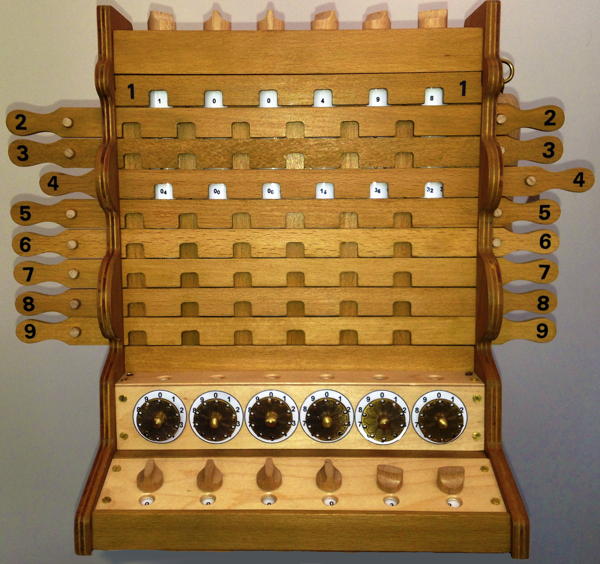 First Devices
First Devices- 2100-2000 BC: Ur III Neo Sumerian Receipt of goods
- ~1894 BC - ~1595 BC: Old Babylonian tag with cuneiform numeric and alphabetic characters
- ‘~150-100 BC’: Antikythera mechanism reconstructed model - basic form by Kostas Kotsanas
- ‘~1150-100 BC’: Antikythera mechanism reconstructed model - with orrery by John Lancashire
- Abacus (Chinese, recent construction)
- 000-200: Ancient Roman Dividers
- 000-300: Three Ancient Roman dice
- 100-200: Ancient Roman bronze astragalus (gaming knucklebone)
- 1480-1520: French Jeton, Late Medieval
- 1577: Calculi Ordinum Belgii, “Port Salu”
- ‘1617’: “Napier’s bones” (recent construction)
- ‘1623’: Schickard’s “Calculating Clock” - reconstruction from surviving manuscript
- ‘~1650’: Blaise Pascal’s “Pascaline” - working exemplar based on surviving machines
- ‘~1650’: Blaise Pascal’s “Pascaline” - replica of The Queen of Poland Pascaline (at Dresden)
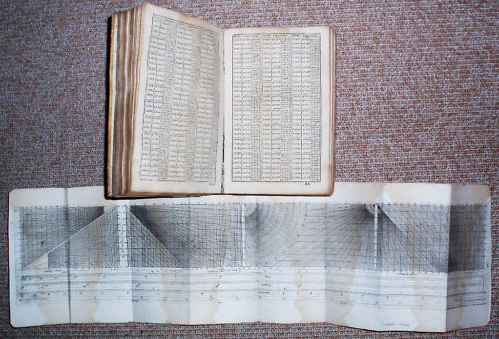 Early Books, Logarithmic Tables, and Ready Reckoners
Early Books, Logarithmic Tables, and Ready Reckoners - 1626: Dennis Henrion: Traicté de logarithmes
- 1668: Gaspar Schott: Organum Mathematicum Libris IX Explicandum
- 1783: Tables Portatives de Logarithmes, by Gardiner improved and perfected in their disposition by M. Callet
- 1892: Ropp’s Commercial Calculator Book, World’s Fair Edition
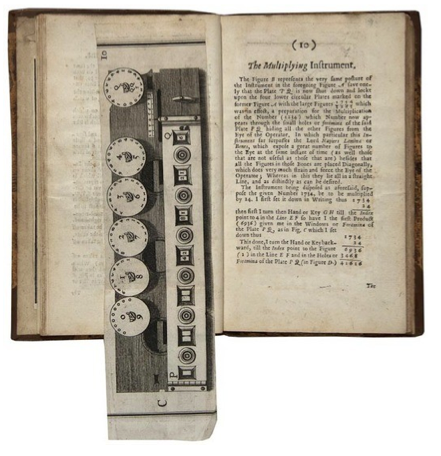 The first “computer manual”?
The first “computer manual”? 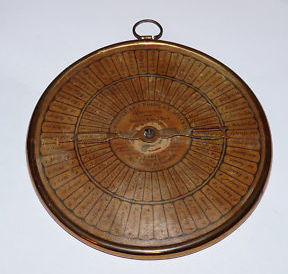 Conversion and Reckoner Devices
Conversion and Reckoner Devices- 1790-1810: Instrument for conversion from Aunes to Metres by Gabrielle CHAIX, Paris
- 1793: Pietr Holm “Tobacco Box” for determining ship’s speed, and perpetual calendar
- 1849: Circular interest reckoner by L. Brooks, Great Falls, N.H. USA
- 1856: Cylindrical multiplication reckoner by J.B. Morill
- ~1876: Tachylemme by Casimir-Louis Chambon
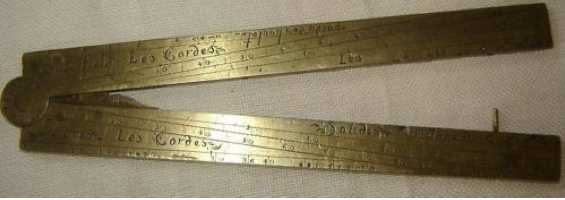 Sectors and Dividers
Sectors and Dividers- 000-200: Ancient Roman Dividers
- 1675-1715: Brass French Gunnery Sector by Michael Butterfield, Paris
- ~1830: Oxbone Architect’s Sector by T. and H. Doublett, London
- ~1740-1810: 2 Pairs of Dividers - made in England
- ~1750-1800 Early print of drawings of Dividers and other Instruments by T. Jefferys
- ~1880 Set of Proportional Dividers and other Mathematical Drawing Instruments by Henri Morin, Paris
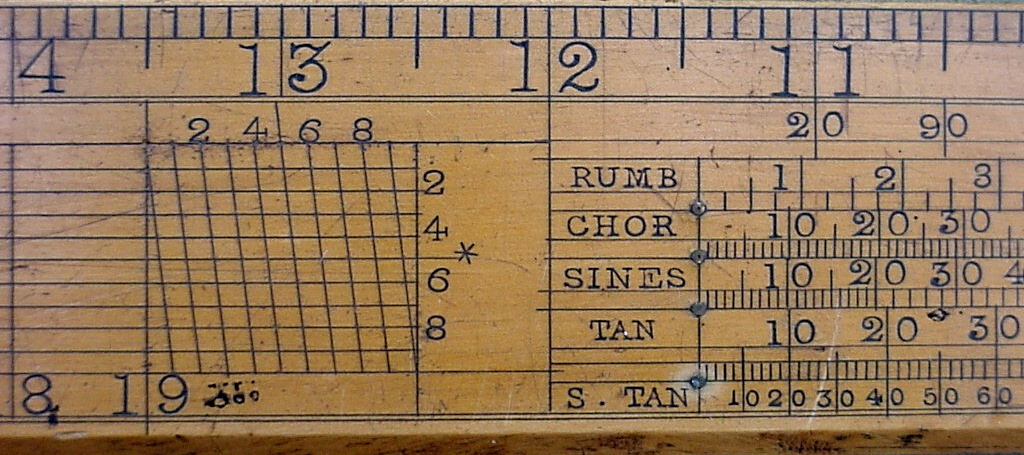 Gunter’s Proportional Rule
Gunter’s Proportional Rule- 1626: Design of a Logarithmic Proportional Rule (following Gunter 1624)
- 1831-1843: Gunter rule for navigation by Belcher and Bros, New York, New York
 Slide Rules
Slide Rules- 1727: Designs of 3 Logarithmic Rules 1626-1726 (as described by Jacob Leupold 1727)
- 1759-69: Edward Roberts Everard Pattern Gauger’s Slide Rule
- 1821-84: Joseph Long, London, Alcohol Proof Index Slide Rule
- 1893-8: Tavernier-Gravet, Slide Rule, cursor inscribed as presented in 1898
- ~1928: Keuffel & Esser 4088-3 serial 348119 Slide Rule
- ~1948: Lawrence 10-G Cutting Speed Calculator
- 1967-73: Faber Castell 2/83N Novo Duplex slide rule
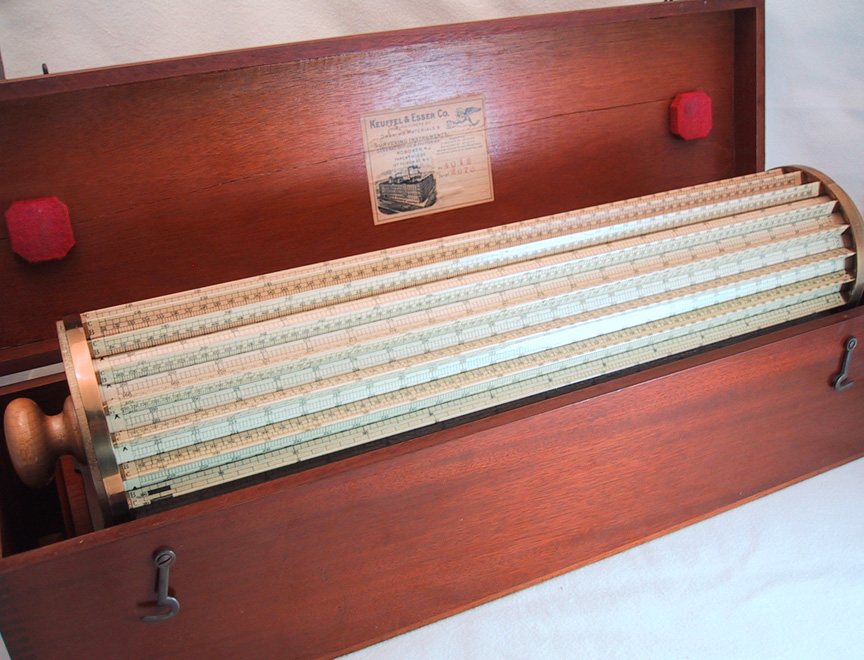 Cylindrical Slide Rules
Cylindrical Slide Rules- 1911: Thacher’s Calculating Instrument, No. 4012 by Keuffel & Esser
- 1926: Professor Fuller’s Fuller Cylindrical Slide Rule Model 2 No. 5706
- ~1960: Otis King Rotary Slide Rule, Type L C, serial T6205, scales 429 and 430
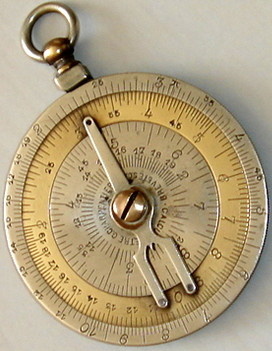 Circular Slide Rules
Circular Slide Rules- 1847: Palmer’s Computing Scale and Fuller’s Time Telegraph, issue 4
- ~1881: Charpentier Calculimètre circular slide rule
- ~1935: Supremathic Circular slide rule
- 1948: Fowler Long Scale Jubilee Magnum extra long scale calculator Fowler’s “Jubilee Magnum” Circular Slide Rule
- 1960s: KL-1 Russian Mechanical Circular Slide Rule and case
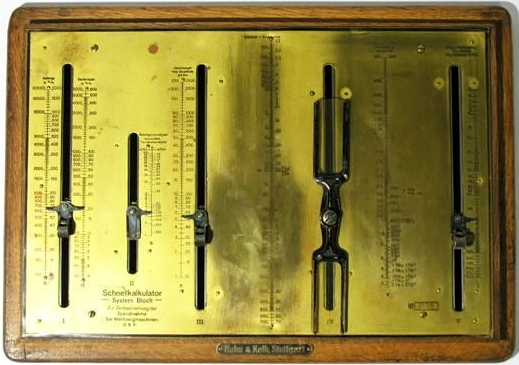 Proportional Nomographic Calculators
Proportional Nomographic Calculators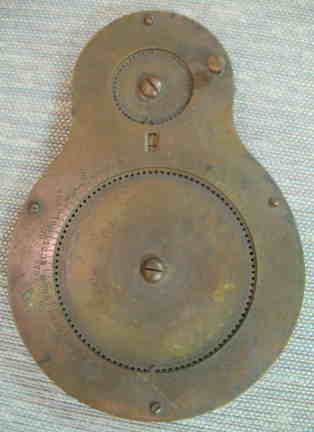 Stylus or Slider operated Adders
Stylus or Slider operated Adders- 1869 model Web Patent Adder and Talley Board serial B2040
- 1889 model Web Adder serial 3220
- 1890-1900: A. M. Stevenson Adder
- 1905-1911: Locke Adder
- ~1912: The Standard Desk Calcumeter
- 1910-1920s Comptator, 9 column
- ~1910 Seidel & Naumann Adding Machine
- ~1910 Adall Concentric-disk Adding Machine
- ~1915: Golden Gem Automatic Adding Machine, serial 73158
- 1920: Addiator Troncet adder
- ~1920: Addo mod 2 adder, serial 2797
- 1922: Scribola 10 column printing Adding Machine
- ~1930: Quixsum model C imperial feet, inches and fractions Adding Machine
- 1937: Add-O-Matic Adding Machine
- ~1946: Lightning Portable Adding Machine
- ~1952: O.J. Adder
- 1968: SEE Demonstration Adding Machine
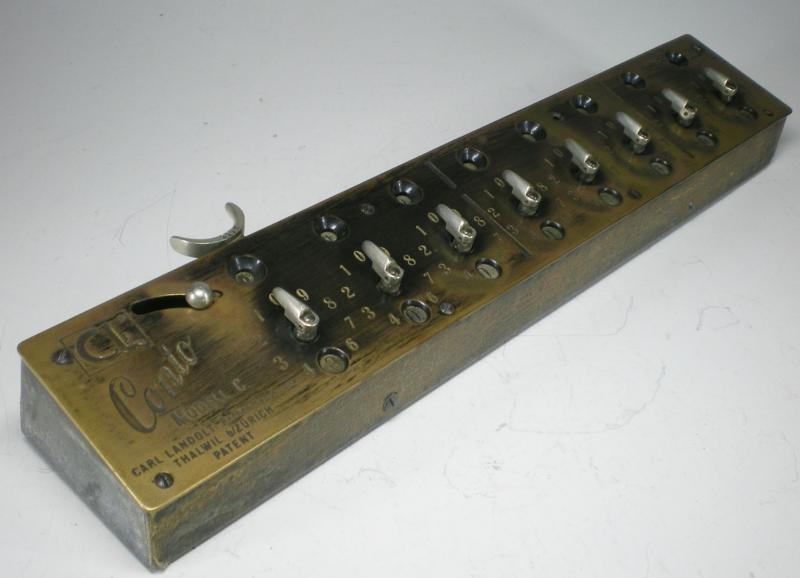 Rotating knob operated Adders
Rotating knob operated Adders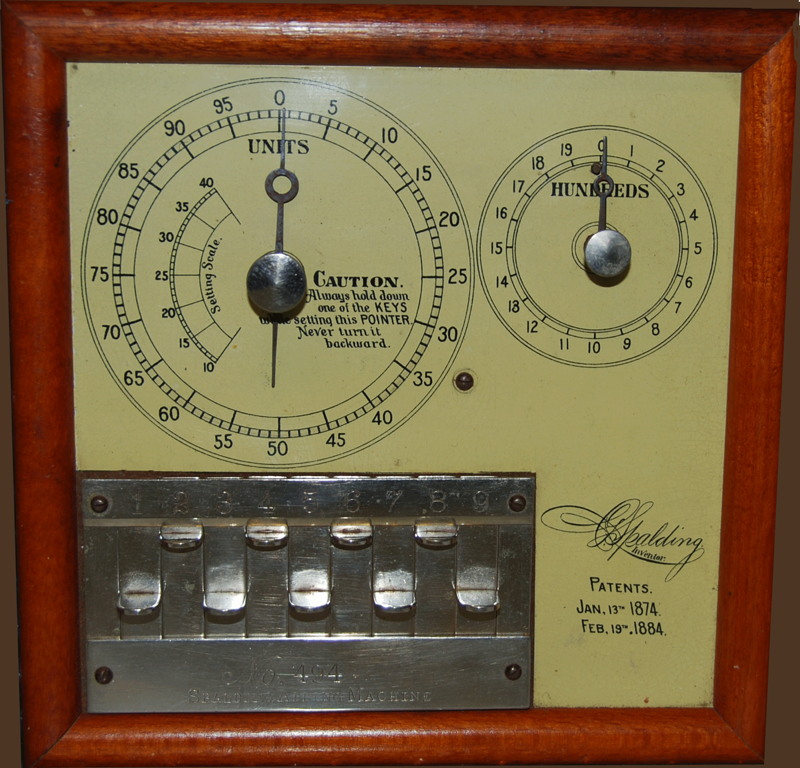 Keyboard Adding Machines
Keyboard Adding Machines- 1884: Spalding Adding Machine, serial 494
- 1891: The Centigraph Adding Machine, serial 1523
- 1903: Adix Adding Machine. Original model
- ~1908: The Adder, serial 1306
- ~1909: Kuli Calculator, serial 1192
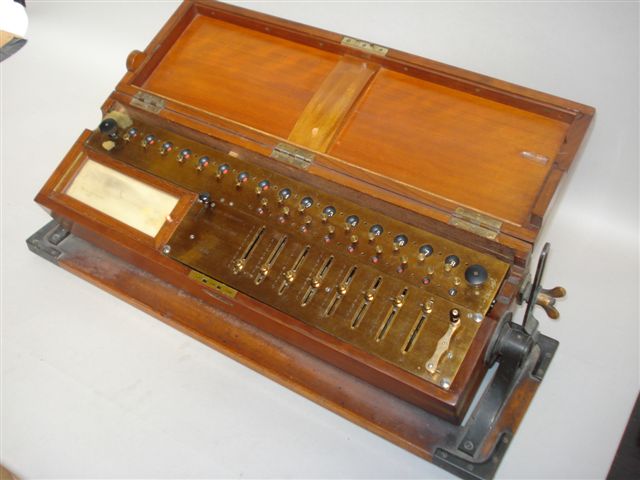 Arithmometers
Arithmometers- 1884: Thomas de Colmar Arithmometer Model T1878 B, serial 2083
- 1909: Ludwig Spitz & Co., G.m.b.H., Berlin-Tempelhof TIM (Time is Money) Arithmometer
- ~1913: Bunzel-Denton Arithmometer Prototype with crank moved to front
- 1917: Madas IX Maxima calculator, serial 5532
 True Multiplying Calculators
True Multiplying Calculators- 1904-1905: Bamberger’s Omega Calculating Machine
- 1912: Millionaire Calculating Machine serial 2015 (10x10x20)
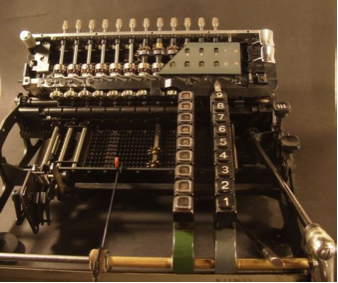 Proportional Rack Calculators
Proportional Rack Calculators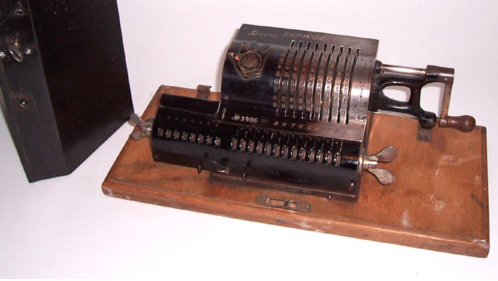 Pinwheel Calculators
Pinwheel Calculators- ~1896: Ohdner Brunsviga Schuster Calculator serial 3406
- 1945: Facit Model S Calculator serial 210652
- 1950: Facit Model LX Calculator serial 105478
- ~1951: Original Ohdner Model 39, Calculator serial 39-288965
- 1957: Walther Demonstration WSR160 Pinwheel Calculator
- ~1957: Walther WSR160 Pinwheel Calculator
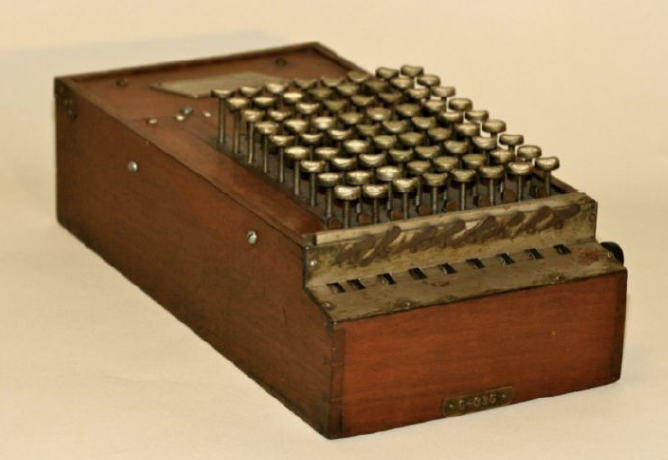 Comptometers
Comptometers- Sept 1896: Felt and Tarrant Comptometer: Earliest - wood-cased “Woodie” model, serial 2491
- ~ 1907: Comptometer oil bottle, marked with patent 23 April 1905; 6 April 1907
- ~ 1955 Bell Punch Sumlock Demonstration Comptometer
- 1950s: Bell Sumlock Comptometer Model 909/S/117.878 (made in Great Britain by Bell Punch Company Ltd)
 The Curta and Alpina miniaturised step-drum calculators
The Curta and Alpina miniaturised step-drum calculators- ~July 1948: Curta Type 1 (pin sliders) earliest model calculator, serial 5424
- 1967: Curta Type I calculator, near mint, with original case, cardboard box and instructions, serial 76436
- 1963: Curta Type II calculator with Leather Case, serial 554765
- 1961: Alpina miniaturised calculator, mint condition, with original case, serial 5944
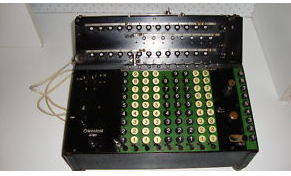 Motorised Calculating Machines
Motorised Calculating Machines- ~1929 “Herzstark” electric Calculating Machine serial 6549, badged by Herzstark, Vienna; essentially Badenia Model TE 13 Duplex
- 1950s-1960s: MADAS Model 20BTG serial 94046 electric calculator with true automatic division
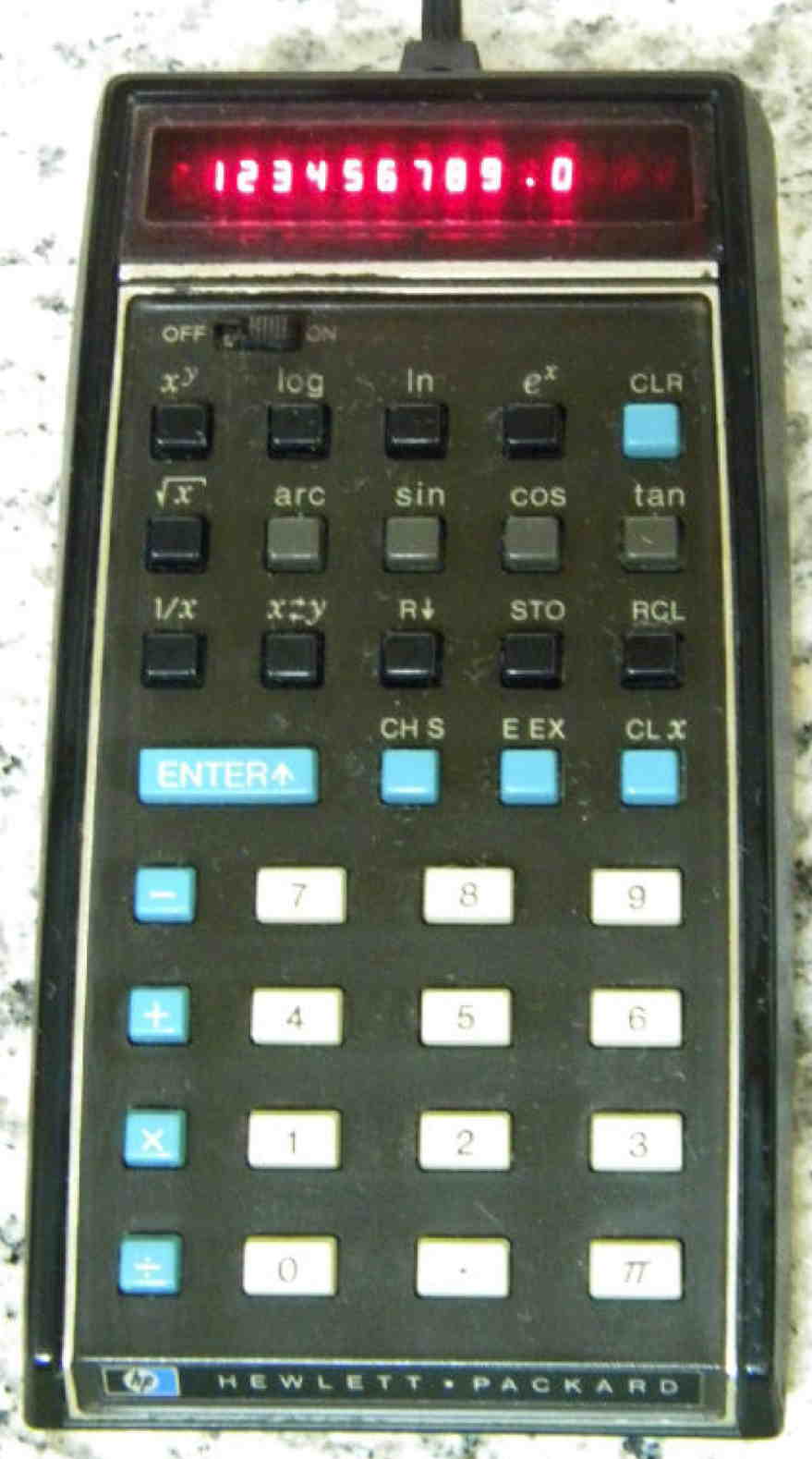 Electronic Calculators
Electronic Calculators- July1972: Hewlett Packard HP 35 Calculator serial 1230A 79429, 1972 (second version)
- December 1973: Hewlett Packard HP 45 Calculator serial 1350A 36719, 1973
- August 1973: Hewlett Packard HP 65 Calculator serial 1333A 06752, 1973
______
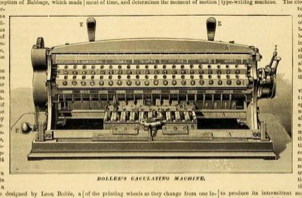 Ephemera
Ephemera- 1759: Algebre et Arithmetique - Machine de Arithmetique de Pascal”, Denis Diderot and Jean le Rond d’Alembert, Encyclopédie ou Dictionnaire raisonné des sciences, des arts et des métiers, First folio edition, 1759, Volume 22, Plate 2. (Hand coloured).
- 1797: Napier’s Rods in “Inland Navigation”, Encyclopaedia Britannica, 3rd Edition, 1797, plate CCCXLIV, Andrew Bell copperplate. Original print article.
- 1855: “Messrs. Scheutz’s New Calculating Machine”, The Illustrated London News, 30 June 1855, p. 661. Original print article.
- 1890: Leon Bollée Calculating Machine, “A New Calculating Machine of very General Applicability”, The Manufacturer and Builder, July 1890, p. 156. Original print article.
- 1895: Booklet on “How to Become a Lightning Calculator”, No. 2
- 1901: “Rechenmachinen [“Calculating Machines” trs.] Bibliogr. Institut in Leipzig, Zum Art “Rechenmaschinen” (Bld. 21). Original wood engraved plate, pp. 1-2. showing engravings of calculating machines by Pascal, Leibniz, Steiger and Egli (Millionaire), Burroughs, Burkhard, Brunsviga, and J. H. Müller.
- 1913: Advertisement by Hertztark Co. for “Austria” Calculating Machine
- 1921: Felt and Tarrant Comptometer Manual
- 1937: Advertisement for Monroe Calculators featuring Marching numbers
- 1973: “HP Measurement/Computation:changing things for the better”, Scientific American, July 1973, pp. 6-7. Original print article. Two full page advertisement for the HP-35, HP-45 and HP-46 scientific calculators.
- 1990: “A Calculator Chronicle: 300 Years of Counting and Reckoning Tools”, from the exhibition at the IBM Gallery of Science and Art, Madison Avenue, 56th Street, New York City”, 1 January 1990
Pages linked to this page
 This work by Jim Falk is licensed under a Creative Commons Attribution-NonCommercial-NoDerivs 3.0 Unported License Click on the logo to the left to see the terms on which you can use it.
This work by Jim Falk is licensed under a Creative Commons Attribution-NonCommercial-NoDerivs 3.0 Unported License Click on the logo to the left to see the terms on which you can use it.